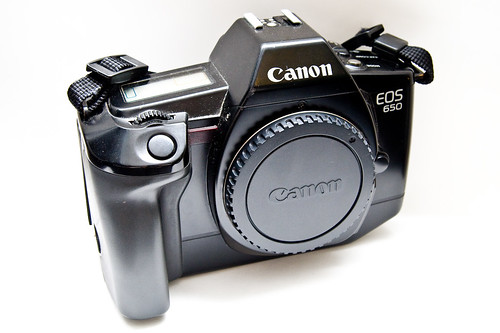Canon EOS 650

|
| Canon EOS 650 image by Rolf F. (Image rights) |
The Canon EOS 650 was introduced in 1987. It was the first EOS (Electro-Optical System) camera, ushering in an era in Canon SLR's that outlived the end of the film era and took the DSLR market by force, a line which is still going strong into the era of mirror-less digital system cameras, some of which now bear the EOS brand as well.
The 650 was a brand new auto-focus system camera, one that was not based on a previous lens mount. With this model, Canon essentially abandoned their manual focus FD camera systems that had been introduced in the 1970's. The EOS was, from the beginning, a full camera system with fast, hands-free auto-focus. The first EF lenses were noticeably lighter than previous auto-focus lenses, and were in fact lighter than many equivalent manual-focus lenses, due to the materials used in their construction. In manual mode, the lenses focus smoothly, with no feeling of turning gears, as the AF-MF switch mechanically disengages the focusing ring from the auto-focus gearing.
The EOS system is built around the EF lens mount. The initialism stands for either Electronic Focus or electrofocus, depending on whom you ask.
The 650 has a full range of shooting modes: Programmed auto-exposure, shutter priority (both as found on most previous Canon SLR's), aperture priority, depth-of-field priority (an advanced mode that allows the photographer to set a specific distance range to be in focus, thus setting shutter, aperture and auto-focus simultaneously) as well as fully manual exposure.
The shutter is a electronic, vertical metal focal plane capable of 30 sec to 1/2,000 as well as 1/125s with flash. The camera is powered by 2CR5 lithium battery rated for up to 100 36 exp. rolls.
Canon also released an EOS 650 QD version that included a "Quartz Date back" for imprinting dates, timestamps, or frame counts on the negatives.
Canon EOS 650 Took the First Photo on the World Wide Web
A photograph of the band Les Horribles Cernettes taken with the Canon EOS 650 on 18 July 1992 became the first photograph ever posted to the World Wide Web. It was taken by Silvano de Cennaro backstage at the Hardronic Music Festival. The photo was originally taken for use as a CD cover but, at the request of World Wide Web creator, Tim Berners-Lee, Silvano provided a copy of the photo in GIF format, edited using Photoshop version 1.0 on his Macintosh. Berners-Lee and his team used the photo as a test image with the newest release of their web server that included support for images. The historical significance of this photograph is described by Les Horribles Cernettes themselves: "That website had a high symbolic value, as for the first time a web page contained info about activities other than Physics. That was the page that opened the World Wide Web to music, arts, fun... life!" [1][2][3]

|
| Les Horribles Cernettes photo from Canon EOS 650 - Unedited image by Silvano de Cennaro (Image rights) |

|
| First Photo on the WWW as posted by Tim Berners-Lee image by Silvano de Cennaro (Image rights) |
Links
- Canon EOS 650 / 650 QD Manual
- Canon Museum: Canon EOS 650 / 650 QD
- Flickr Canon EOS 650 group
- Canon EOS 620 and 650 review at Ken Rockwell
- Canon EOS 650 at Malaysian Photography Website mir.com
| Japan Camera Grand Prix | |
|---|---|
| Camera of the year
1984: Nikon FA | 1985: Minolta α-7000 | 1986: Canon T90 | 1987: Canon EOS 650 | 1988: Kyocera Samurai | 1989: Nikon F4 | 1990: Canon EOS 10 | 1991: Contax RTS III | 1992: Pentax Z-1 | 1993: Canon EOS 5 | 1994: Minolta α-707si | 1995: Contax G1 | 1996: Minolta TC-1 | 1997: Nikon F5 | 1998: Pentax 645N | 1999: Minolta α-9 | 2000: Canon EOS-1V | 2001: Minolta α-7 | 2002: Canon EOS-1D | 2003: Canon EOS-1Ds | 2004: Nikon D70 | 2005: Konica Minolta α-7 Digital | 2006: Nikon D200 | 2007: Pentax K10D | 2008: Nikon D3 | 2009: Canon EOS 5D Mark II | 2010: Olympus Pen E-P1 | 2011: Pentax 645D | 2012: Nikon D800 | 2013: Sony DSC-RX1 | 2014: Nikon Df | 2015: Canon EOS 7D Mark II | 2016: Sony α7R II | 2017: Olympus OM-D E-M1 Mark II | 2018: Sony α9 | 2019: Lumix S1R | 2020: Sony α7R IV | 2021: Sony α1 | 2022: Nikon Z9 | 2023: Sony α7R V Special Prize Editor | |